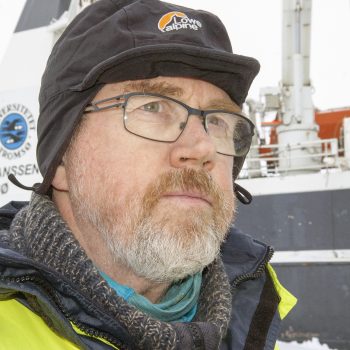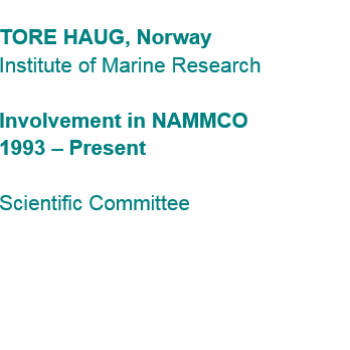October 15, 2018: Behind NAMMCO – Tore Haug
The People Behind NAMMCO:
25 years of dedication to NAMMCO’s Scientific Committee – having had a leading role many times since it’s inception – the Chairman of SC 25, Tore Haug:


Period of involvement with NAMMCO:
Appointed Norwegian member in the Scientific Committee from 1993, vice chairman 1993-1994 and 2013-2015, chairman 1995-1997 and 2016-2018. Chairman in “NAMMCO Scientific Committee Working Group on Northern Bottlenose and Killer Whales” in 1993-1994, convenor for the NAMMCO symposium ”Harbour porpoises in the North Atlantic”, held on the Norwegian coastal steamer in September 1999.
Involvement:
My earlier scientific experience (1981-1989) were linked to fish biology and Arctic fish communities. In 1989 I was employed at the IMR to work with management related research on marine mammals (abundance, biology and ecology of whales and seals in Norwegian and adjacent waters). I am currently leader of the Marine Mammals Research Group at the Institute of Marine Research, previously (1993- 2015) and also employed as professor II at UiT.
IMR give scientifically based advice to national authorities on all issues related to marine resource management and utilization. For this reason, IMR scientists are deeply involved in work in international management bodies such as ICES, IWC and NAMMCO.
There have been significant achievements of NAMMCO during the first 25 year of its existence. Several examples demonstrate that management matters and works: Negative trends in populations of species such as walrus, narwhals and belugas have been stopped and even reversed due to good management based on advice from the SC of NAMMCO. Furthermore, NAMMCO has succeeded in getting coastal seal management from its previous “home-made” approach and into a scientific working group that now enables the NAMMCO SC to give good advice. The advice-producing Working Group on Harp and Hooded Seals were recently included into the NAMMCO framework without losing the original ICES (and NAFO) affiliation which is very important since it secures the participation from two additional important seal-hunting nations in the North Atlantic: Canada and Russia.
Evidently, large whale issues are still something that our politicians have decided that we must share with the International Whaling Commission (IWC). It is obvious that the IWC is developing more and more into a dysfunctional organization when it comes to the original aim: to manage whaling. At some point – presumably when IWC has transformed into a pure whale conservation organization – I assume that the large whale assessments and management in the North Atlantic will be an important NAMMCO-only issue. In the meantime, NAMMCO must focus on other important issues, such as by-catches of whales and seals in various fisheries.
Highlights:
My most spectacular field work experiences are no doubt the surveys where we count harp and hooded seal pups to obtain input data to the population estimate models we use. The drift ice habitat with thousands of seals on is simply stunning, and the survey itself is also quite spectacular with all the logistics, including an ice going vessel, helicopter and aircrafts. The IMR director has named it “The James Bond survey”, so we go to the West Ice under the motto: Shaken, not stirred!


